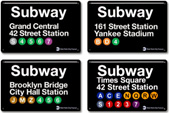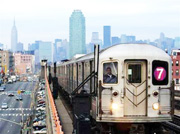Some things can be stressful, strange, boring, sexy, fearsome and fascinating at the same. But where most of them balance those elements with predictable cohesiveness, riding the New York subway is a perennially moving roulette wheel where any one of them can any stand out at any given time.
That's why, of the eight million fascinating stories happening in New York every day, some of the best ones are underneath the ground.
Do's and Don'ts of the New York Subway

If that doesn't excite in you a romantic notion of raw communion with the city in its purest spirit, the very successful (it carries over 1,500 billion passengers a year) New York subway has more incentives for you. It is relatively inexpensive. It is speedy (it takes an average of three minutes to travel through 20 blocks). But chief among them is how endlessly practical it is: it can take you pretty much anywhere in Manhattan, as well as Queens, the Bronx and Brooklyn. Which means you'll probably use it as much as your legs to get about in town. What it doesn't mean is that the New York subway is an easy thing to ride: getting lost in one of the biggest subway systems in the world is easy.
The New York subway does not work like a lot of other systems in the world. Trains are organized through numbers and letters and they don't indicate their final destination as a way to inform you of the direction they are taking. Instead, what you will see in the entrances and platforms are "Uptown" and "Downtown" signs (and this is only for trains that terminate in Manhattan -- be prepared to find a few "Uptown and the Bronx/Queens" and "Downtown and Brooklyn" signs). Since not many trains travel crosstown, what you need to know first is whether you are going up or down. On the 7 train, it says either Manhattan- Times Square or Main Street- Flushing. On the L train it says either Manhattan-8th Avenue or Brooklyn-Rockaway Parkway.

There are several ticket options you can choose from: a single ticket; a 11-ride Metrocard to which you can add more money when you so need; and two kinds of unlimited ride Metrocards, one that lasts a week and one that lasts a month (costing about 3 times more than the weekly card).
Do's and Don'ts
- Do check the MTA New York City Transit web site before you hop on any train. It will give you detailed information on what stations are best for you, and what's the best train to move between them.
- Don't ask the station agent for a map of the subway. You technically can, but you will be stating to every passenger around that you are a tourist here. And not every passenger has the best intentions. Also, there are maps in the walls of every station and every train which you can use less conspicuously.
- Do take off your backpack and hold it in your hands. You will find it hard enough to move around without it, so there's no need to add an extra bump.
- Don't get on a subway car that's empty in rush hour. It's probably empty for a reason you're better off not discovering. Also, if you are traveling late at night (and a lot of the subway's lines open until late at night), it's best to leave the empty cars the way they are.
- Do be quick when you are looking for a seat in the car. New York subway cars start soon and fast.
- Don't put your belongings in an empty seat next to you. Not only is it rude, it can result in a court citation and a fine up to $500.
- Do take good care of your MetroCard. Unlike those in Paris or Madrid, New York metro cards are made of cardboard and will stop working if they are bent, heated or humid. Also keep them away from electronic devices that could de-magnetize them.
- Don't get on an express train without realizing it. It happens more often than anybody would like to admit to. Local trains stop at every stop along a line. Express trains skip some stops. It can technically help you discover and new and wondrous hidden location in town. But it is more likely to be a hassle.
- Do remember that many stations have separate platforms and entrances for trains going in opposite directions. If you go the wrong way, (even if you are trying to backtrack from one of these stations because you missed you stop), You will have to pay twice if you use the wrong entrance or if you missed your stop and try to backtrack from one of these stations. This warning is less likely to apply to transfer and express stations.
- Don't open the 22-inch-wide broadsheet The New York Times while in the subway. It's not that you are only allowed a strict amount of space, but taking more than you normally need does not sit well among other travelers. Just think that of all the people around you, there's probably one in five that is giving up his reading material for the convenience of others.

